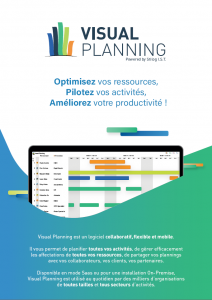In project management, little time is spent talking about the difficulty of building a project schedule with the right time estimates. And today, I am going to focus on that aspect. When you start a project, one of the first question that pops very quickly is: “When will it be ready?” If you don’t believe that project deadlines are useful, or you simply don’t know how you could possibly provide an exact date for such a long project, be sure that somebody will break under pressure and give a date, which you will be held to.
When that date comes and you are not ready to deliver – because your estimates are always too optimistic – rest assured that you will make some people unhappy. Sales will be angry at you because they already promised an important customer it will be ready for today, and your team will be angry at you because they worked like crazy to an impossible deadline. That’s why I worked on a few tips that will help you create a realistic project schedule (that you can be proud of).
GATHER ALL THE INFORMATION
This step will set the roots of your entire project schedule. “Knowledge is power” they say, so make it your mantra and work as if you wanted to learn and know everything. And by everything, I mean every little detail that might help you: what are the project requirements? How many stakeholders? Who are they? Resource availability… Do not neglect details – even the smallest ones – they might seem useless now but they may have a larger impact at a certain point in the project. Let’s take an example: imagine that you own a cake shop and that you have to deliver a certain amount of cookies to your most important customer. A part from the much-vaunted deadline, you will need a certain amount of information to fulfill your mission: how many cookies? What kind of cookies (chocolate chip, peanut butter….)? Are there any allergies or food specifications?
Having all the initial requirements will enable you to have a clear view of the project in its entirety. Ask questions and don’t be afraid to ask them twice or ask for clarifications; just make sure nothing get past you. This step can seem unnecessary, but losing time and money because of a lack of visibility into project requirements is a common mistake. (” Oh you needed 5000 GLUTEN-FREE cookies and not regular ones? “). In this case fixing it can be very costly and increase the time estimates of your project schedule.

BREAKDOWN YOUR TASKS
Before any task breakdown, it is important that you start by demanding confirmation of every project requirement and specification you wrote down. Make sure everybody agrees on everything.
Then, start drafting an accurate plan of action. The best way to do it would be to break down your tasks. Ideally, tasks need to be small enough that they can be assigned to a single person
If we go back to the cookie order, breaking down your tasks would look like:
- 1: Confirm the requirements (10 min)
- 2: make a shopping list of everything you need e.g. gluten-free wheat, gluten-free chocolate chips, brown sugar, etc (2 hours)
- 3: buy all the ingredients from the supplier (4 hours)
- 4: bake a first batch of cookies to test (5.5 hours)
- 5: bake the full order (36 hours)
- 6: design a customized packaging for your client (16 hours)
- 7: package (8 hours)
This way, you can start estimating the time each task will require. Keep in mind that if you don’t break down your task plan, you might forget a crucial step or get wrong estimates for a large task that should have been broken down in the first place. A task breakdown will enable you to have a clearer view, and when tasks are smaller, time estimates are easier to determine. The smaller the tasks are, the easier it will be to deal with each task. And if it is your first time putting together a task breakdown, some research might be a great help. And by digging a little bit, you might find a template adapted to your project.

INCLUDE ERROR MARGINS
You must keep in mind that external factors will come and affect your schedule. Whether it is a delay from a supplier, a broken machine or a sick leave from an employee, you should always expect that unforeseen events will impact your schedule. A notable best practice to mitigate unexpected delays is to prepare an accurate plan of action for when those unforeseen events happen. You could, for instance, include in your estimates additional time at the end of each task or group of task, and prepare a list of emergency solutions in case of delays or absence of a resource.
INCLUDE MILESTONES IN YOUR PROJECT
This step is a game changer (or a real life saver). Let’s say that you implement a milestone after every group of task (confirm the requirements and make a shopping list: milestone, buy all the ingredients: milestone…), if you stop at each milestone, double-check everything and validate the task, then it means you can keep working on solid grounds. Needless to say that it adds more time to your estimate but at least you know it, and your schedule will be revised accordingly. On the other hand, if you can’t validate, it means that something is wrong and that you need to spend more time on it, and honestly it is better to spend an additional hour on every task than spending more days at the end of the project because everything is falling down.
If there’s any doubt, critical path is not what we are suggesting here. Although critical path has its benefits, your project doesn’t necessarily need constraints that might impact your scheduling process. Keep your flexibility, no need to add complexity unless it is absolutely necessary.
DON’T LET BAD ESTIMATES GET IN YOUR WAY
Sometimes you are not the one who sets the project deadline, and I understand that you want to please your biggest customer, your boss or your colleagues from Marketing. But if you think the dates are too optimistic, you need to speak up! And I would strongly advise you to speak up before you start working on the actual project. Once again, working to an impossible deadline is not the best thing to do. The earlier you start the schedule due diligence, the sooner you can spot deadline issues & bottlenecks.
As demanding as all this sounds, I assure you it will save you from a lot of troubles down the line (and it gets easier with time). And if you need some help, you can always get a scheduling tool. Such tools will be able to help you on so many levels. On top of scheduling all your tasks with a simple drag & drop, one of the greatest thing with project scheduling tools is that you can get analytics & reports out of your projects. Therefore, you will be able to track any bad estimates and prevent from doing the same mistakes in your future projects. Now that you have more knowledge, I am sure your next projects schedules will be terrific.



